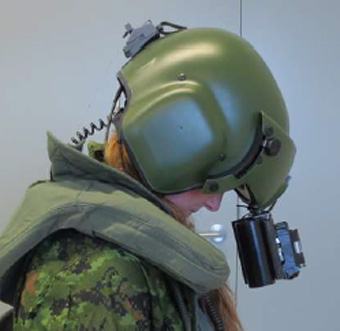A pain in the neck
December 12, 2014
Share
For 70 per cent of helicopter aircrew in the Royal Canadian Armed Forces (RCAF), a helmet equipped with the necessary night vision goggles and battery pack causes real pains in the neck.
To help alleviate this pain for RCAF aircrew members, Steven Fischer and his research team from the School of Kinesiology and Health Studies have designed a short-term solution in the form of a simple add-on to back of the standard military helmet.
Currently, RCAF aircrew don a large helmet before takeoff. For night-flying, aircrew must also affix night vision goggles to the front of their helmet. Even though it’s only an extra 1.8 kg, the added weight can cause significant neck pain for those flying the helicopter as it causes an increase in the muscular demand of their necks to hold their heads upright.

“We’ve designed a device that can be added to the back of the helmet to help support the muscles in keeping head balanced when the extra weight is placed on the front of the helmet,” says Dr. Fischer, who received the 2014 Major Sir Frederick Banting Award for the best oral presentation related to military health, as selected by the Surgeon General, at this year’s Canadian Institute for Military and Veteran Health Research (CIMVHR) Forum.
“Our aim was to be able to reduce the strain on the neck to day flight levels at a minimum. While it’s only a short term solution – a long term solution being a redesign to the entire helmet and night vision goggles system – we needed something practical and easy for pilots to use, that they could wear in the interim.”
After in-lab trials with the device, wearers reported considerably less neck-related pain or fatigue. The team is now working on the device’s ability to adjust/individualize the tension depending on the wearer.
Now that the development phase of this device is completed, the evaluation phase is well-underway with in-flight testing scheduled for the coming weeks.
The research team for this project also includes Jenna Dibblee, Portia Worthy, Joan Stevenson, Susan Reid, and Markus Hetzler.
For more information on the Banting Award, Forum 2014 or CIMVHR, follow this link.